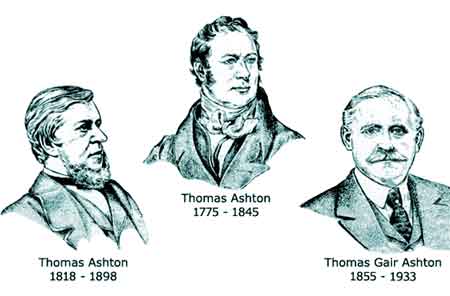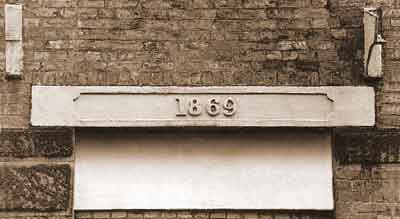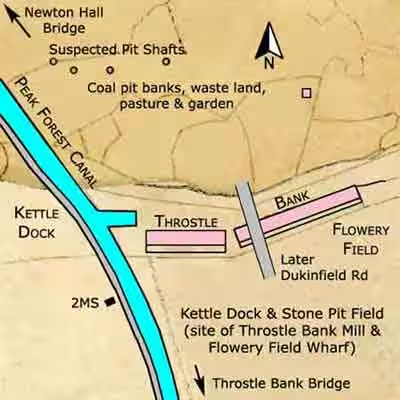
Throstle Bank and Kettle Dock were situated on the offside of the canal between Newton Hall and Throstle Bank Bridges, Flowery Field, Hyde. Throstle Bank consisted of two rows of terraced houses set at an obtuse angle to each other. Later, Dukinfield Rd was constructed between them.
Referring to the Tithe Map below, the land to the north of Kettle Dock is referred to as 'Coal pit banks, waste land, pasture and garden'. This suggests that prior to the date of this map (1841) that waste material from coal pits was disposed of in this area and four suspected pit shafts have been identified on the map. The land to the south of the dock is referred to as 'Kettle Dock and Stone Pit Field'. This information supplies the name of both the dock and of a named pit but the location of this is unknown. The siting of Kettle Dock suggests that it was used as a loading stage where boats could be filled with coal from a number of shallow pits in the vicinity.
At the time of this Tithe Map the landowner of 'Kettle Dock and Stone Pit Field' was Edward Hyde Clarke and the occupier was Thomas Ashton (1775-1845). Edward Hyde Clarke resided at Hyde Hall, a short distance to the south, while Thomas Ashton (1775-1845) was the founder of the textile industry in Hyde, based at Flowery Field. He was responsible for creating one of the largest and longest-lived textile companies and when he died in 1845 he left the business to his two sons, Samuel Ashton (7 Nov 1804-Apr 1860) and Thomas Ashton (1818-1898), along with the majority of his personal estate and property, which was worth just under £60,000. In 1854 Samuel Ashton and his brother, Thomas Ashton, formed Ashton Brothers & Co out of their father's business, maintaining its position of one of the largest independent employers in Hyde until its sale to Courtaulds in 1968. The Ashton family founded several cotton mills in the area, including Apethorn Mill and Woodley Mill, the latter being built in 1828. Thomas Ashton ran Bayleyfield Mill, Carrfield Mill, Balaclava Mill and Throstle Bank Mill at Hyde, while Samuel Ashton ran the mills at Woodley and Apethorn. Balaclava Mill was built between Bayleyfield and Carrfield Mills at Flowery Field and it was given this name because it was built at the time of the Battle of Balaclava in 1854. As well as their interest in textiles the family established a calico printing works and they also had coal-mining interests.
The brothers, Samuel Ashton and Thomas Ashton, were especially noted for operating cotton mills that did both spinning and weaving and this proved to be a successful venture when most mills specialised in either spinning or weaving but not both.
Management of the family business in Flowery Field, Hyde, then passed to Thomas Gair Ashton, 1st Baron Ashton of Hyde JP DL (5 Feb 1855-1 May 1933). He was the son of Thomas Ashton (1818-98) and Elizabeth Gair and he was born in Fallowfield, Manchester. He was educated at Rugby and University College, Oxford. He married Eva Margaret James in 1886 and he was raised to the peerage on the 28 Jun 1911. In 1892 he was awarded an Honorary Freeman of the City of Manchester and in 1923 he was awarded an Honorary Fellow of Oxford University. In addition to his expertise as an industrialist, he was also a philanthropist and Liberal politician. He was the Liberal MP for Hyde (1885/86) and Luton (1895-1911).

By c.1875, a building had been erected over the site of Kettle Dock fronted by a wharf, so the dock was filled in to enable this to be constructed. Directly to the south of the site of the dock, Throstle Bank Mill and Flowery Field Wharf were built on 'Kettle Dock and Stone Pit Field'. Each floor of mill was fitted with a lintel bearing the date 1869, showing the year that the mill was built.


Throstle Bank & Kettle Dock
Lower Peak Forest Canal
Tithe Map: 1841
Courtesy: Cheshire Archives & Local Studies

Throstle Bank Mill and Flowery Field Wharf, Hyde, 1920s.
These were owned by Ashton Brothers & Co Ltd who also owned the nearby Carrfield, Balaclava and Bayleyfield Mills.
Note the bales of cotton on the wharf sheeted over with tarpaulin. The boat, Mary, belongs to James Hall, Carrier by Canal of Droylsden.
The mill got its name from the use of the throstle spinning frame, which was an early type of ring spinning frame introduced in c.1810 and known to have been in use by 1813. The frame was so called because of the noise it made, which was said to resemble the singing of a throstle (thrush). These frames were used for the continuous drawing, twisting and winding of cotton simultaneously onto banks of up to 300 or 400 bobbins.
Throstle Bank Mill is no longer extant but the name survives in Throstle Bank St.